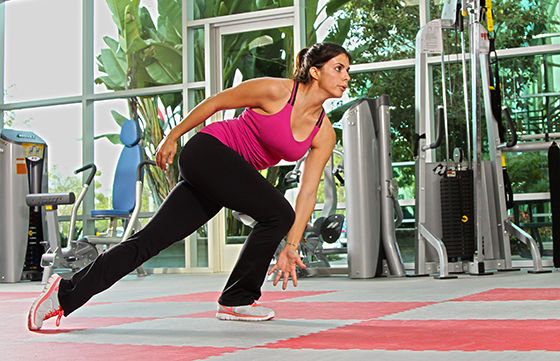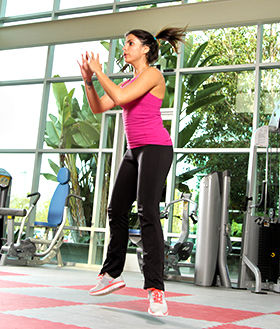
When it comes to weight and general health, there’s no question that exercise plays a vital role in the equation. Yet here’s the million-dollar question: How much exercise do you need to do to see results on the scale? Or even get fitter?
The answer may surprise you. In a nutshell, while more is good, less may actually be better, depending on the situation, which could be good news for time-crunched individuals.
Understanding Current Guidelines for Activity
The debate about how much exercise is enough to move the scale—or at the very least, maintain weight loss—and get healthy has been raging for years. In 2008, though, the government helped answer that question, releasing the most comprehensive set of guidelines for physical activity requirements for Americans. For adults, the guidelines recommend logging 2.5 hours of moderate-intensity aerobic activity or 75 minutes of vigorous-intensity aerobic activity each week. (At least two days of strength training is also prescribed.) If people want to achieve even more health benefits, they’re encouraged to perform up to five hours of moderate-intensity aerobic activity or 2.5 hours of vigorous aerobic activity each week.
Yet getting people to log even the minimum amounts of activity remains a challenge. The stats are alarming: Almost 80 percent of Americans aren’t meeting recommended guidelines, according to new data from the Centers of Disease Control and Prevention.
Numerous obstacles keep people from exercising, but one of the most cited is lack of time. In a survey from Bodybuilding.com, 36 percent of respondents admitted that lack of time kept them from meeting their fitness goals. So what’s the answer? Enter one of the most popular less-is-more solutions: High-intensity interval training (HIIT), which is characterized by periods of relatively intense effort alternated with active recovery.
Get Intense to Get Lean
Lest you think, though, that HIIT workouts offer a get-out-of-jail-free pass because they’re shorter, know this: “HIIT is demanding, so demanding that you have to mentally gear up for it,” says Martin Gibala, Ph.D., professor and chair of the department of kinesiology at McMaster University in Ontario, Canada. In Gibala’s studies, the typical HIIT workout lasts between 15 and 20 minutes and often alternates between 30 seconds of all-out intensity—“it’s the longest 30 seconds of your life,” he says—and four minutes of recovery repeated four or five times.

Although weight loss hasn’t been the focus of Gibala’s studies, especially because they’re relatively short, lasting only six to eight weeks, participants usually do lose small amounts of weight and experience some change in body composition. Another bonus? “Evidence also shows that HIIT may be more effective at targeting abdominal fat than steady-state endurance workouts,” he says.
Doing HIIT can also get people fitter in just a matter of minutes. “After just a few weeks of doing HIIT, your heart is a stronger pump, your muscles are better at using the oxygen that’s being delivered, and you’re generally less fatigued doing physical activity,” Gibala says.
What’s the magic behind HIIT? Two factors. For starters, even though the workout duration is relatively short, the effort level is high, which means people are burning a good number of calories during those high-intensity efforts. Then there’s the post-workout calorie burn. “The after-burn of HIIT is comparable to more traditional cardio workouts,” Gibala says. “That small but sustained elevation in calorie burning adds up over time.”
A study presented at the American College of Sports Medicine’s annual conference in May, for instance, found that a Tabata routine (20-second bouts of high-intensity work followed by a 10-second break and repeated eight times during a four-minute period) burns 13.5 calories a minute and doubles a person’s metabolic rate for 30 minutes after the workout. “The afterburn you get would require you to do 20 minutes of regular cardio—like speed-walking at 4.5 miles per hour, which is a super-fast walking speed—to burn the same [number of] calories,” says lead study author Michele Olson, Ph.D., principal researcher at the Auburn University Montgomery Kinesiology Laboratory in Montgomery, Ala.
Designing a HIIT Workout
Although there’s no magic formula for designing a HIIT workout, keep these guidelines from Gibala in mind when designing HIIT workouts for your clients or yourself:
- HIIT can be used with any cardio activity, but if you’re working with people who have joint issues, veer toward low-impact activities like swimming or cycling versus running.
- General rule of thumb: The shorter the work period, the harder your clients will have to work.
- One of the easiest-to-configure HIIT workouts alternates between one minute of hard work followed by one minute of active recovery repeated 10 times.
- How many HIIT workouts your clients do will depend on their preferences and goals, but generally, more than two per week is pretty demanding.
HIIT, though, isn’t only effective for cardiovascular exercise. It can also be used with circuit strength training, as demonstrated by a seven-minute, high-intensity circuit-training (HICT) workout designed by researchers at the Human Performance Institute in Orlando, Fla. The workout, which is based on HIIT, consists of 12 aerobic and body-weight resistance exercises performed for 30 seconds followed by 10 seconds of rest.
While the workout was originally designed for corporate executives who needed a quick but effective workout they could do in a hotel room, it could benefit anybody with limited time to exercise, and even offer a change of pace to committed fitness enthusiasts. “At the correct intensity, a single seven-minute circuit, performed regularly on three non-consecutive days a week can provide moderate aerobic and muscular fitness benefits,” says Chris Jordan, M.S., C.S.C.S., co-designer of the seven-minute workout and director of exercise physiology at the Human Performance Institute in Orlando, Fla. “In fact, our research indicates that fitness benefits can be attained from HIIT in as little as four minutes.”

Putting Together a HICT Workout
If you have clients interested in HICT workouts, especially if they travel and want a quick workout they can do on the road, follow these guidelines:
- Sequence resistance exercises to allow muscle groups to recover: “This will ensure that exercises are performed with quality and with minimal rest between exercises,” Jordan says. For instance, do a lower-body exercise followed by an upper-body exercise and then a core exercise and repeat from the top. Or do a lower-body exercise, upper-body “push” exercise, upper-body “pull” exercise, a core exercise and then repeat the sequence.
- Add aerobic training to the sequence to increase cardiovascular training and total caloric output. Think jumping jacks, running in place or mountain climbers.
- Make rest periods between exercises as short as possible.
- Use a variety of exercises. “Variety is important for long-term fitness improvement,” Jordan says.
- Don’t forget the warm-up, which should focus on dynamic movements, and the cool-down.
Ideally, Jordan recommends repeating this seven-minute circuit two or three times on three non-consecutive days a week. Do that, he notes, and you’ll have accumulated almost 75 minutes of vigorous intensity exercise, which would be enough to meet guidelines for aerobic activity.
The key, of course, remains intensity, as the shorter the workout, the greater the intensity needs to be. Yet, while anybody could do a HICT workout, “going at full-out intensity might be best for people who have achieved at least an intermediate fitness level,” Jordan says.
Playing With the Frequency Variable
Let’s say, though, you do have clients who can’t—or won’t—do vigorous-intensity exercise. What if you toyed instead with another variable and cut the number of days they exercised?
That’s what researchers set out to find when they recruited 72 older sedentary women, ages 60 to 74, and assigned them to one of three groups. In the first group, women lifted weights once a week and did an endurance workout like jogging or bike riding another day. The second group did the same workouts, but repeated each one twice a week for a total of four days a week. Meanwhile, the third group logged six days of workouts, splitting them evenly between resistance training and cardiovascular work. By the end of the four-month study, all of the exercise sessions lasted 40 minutes.
Researchers had hypothesized that women doing the highest amount of exercise would become more depressed and fatigued from doing so much exercise, as other studies have indicated. “There’s a natural tendency from what’s considered an overstress syndrome for people to withdraw from exercise and be less active,” explains Gary Hunter, Ph.D., lead study author and professor in the department of human studies and nutrition sciences at the University of Alabama in Birmingham. Yet while all of the women improved strength, muscle mass and aerobic fitness, none of them showed signs of any stress. They also lost a small amount of weight, although Hunter notes that greater amounts of weight loss would require a change in diet, which these women weren’t advised to do.
However, one interesting change did occur in what’s called non-exercise activity thermogenesis (NEAT), which is the energy expended during activity logged outside of sleeping, eating or exercising. While the women doing four days of exercise each week increased their daily NEAT calories by an average of 200, women in the six-day-a-week exercise program decreased NEAT by about 150 calories. “Because we didn’t see any overstress, we can only guess that these women felt like they didn’t have sufficient time to do other things like walk the dog or garden,” Hunter says. That decrease in daily activity could add up over time, possibly pushing the scale in the wrong direction.
Bottom line? “If somebody’s cutting quite a few calories, six days a week of exercise is probably a little extreme,” Hunter says. Instead, four days a week, combined with changes in dietary habits, might be a more effective strategy, especially for time-pressed individuals.

How These Workouts Fit Into Traditional Exercise Programs
So does all of this mean there’s no need anymore for more traditional cardio and strength workouts? Are more frequent exercise sessions unnecessary? Absolutely not, as all of them still hold merit, especially if you’re working with endurance athletes, people interested in powerlifting or body building, or individuals who just enjoy exercising.
After all, there’s no cookie-cutter program for everybody, and if you have clients who have the time and desire, encourage them to do a combination of HIIT (which will keep them motivated, Gibala says), longer cardio workouts and strength training. “It’s not HIIT versus traditional cardio, as they both hold merit,” he says. “It just depends on what your goals are and how much time you have to devote to exercise.”
On the other hand, working harder for shorter amounts of time or decreasing workout frequency could be an effective strategy for individuals who want to lose or maintain weight, as well as get fit, but lack the time or motivation for longer workouts. Just keep in mind that, because HIIT and HICT workouts are designed to be intense, you’ll have to tailor the intensity to each of your clients, especially if you’re working with new exercisers.
“They can still do HIIT, but it might be a matter of pushing them only slightly out of their comfort zone, versus doing incredibly vigorous activity,” Gibala says.
The upshot of all these new findings? It’s all about working smarter and harder, not necessarily longer, which could help motivate people who want to control weight and get fit start—and stick with—exercise.





 by
by 





